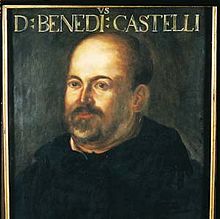Benedetto Castelli
Benedetto Castelli | |
|---|---|
 | |
| Born | 1578 |
| Died | 9 April 1643 |
| Nationality | Italian |
| Alma mater | University of Padua |
| Scientific career | |
| Fields | Mathematician |
| Institutions | University of Pisa |
| Academic advisors | Galileo Galilei |
| Notable students | Giovanni Alfonso Borelli Evangelista Torricelli Bonaventura Cavalieri Antonio Nardi Raffaello Magiotti |
Benedetto Castelli (1578 – 9 April 1643), born Antonio Castelli, was an Italian mathematician. Benedetto was his name in religion on entering the Benedictine Order in 1595.
Life
Born in Brescia, Castelli studied at the University of Padua and later became an abbot at the Benedictine monastery in Monte Cassino.
He was a long-time friend and supporter of his teacher, Galileo Galilei, and in turn teacher to Galileo's son. He assisted Galileo's study of sunspots and participated in the examination of the theories of Nicolaus Copernicus. Castelli was interested in mathematics and hydraulics. He was appointed as a mathematician to the University of Pisa, replacing Galileo, and later at the University of Rome La Sapienza. Castelli introduced Cavalieri to Galileo, leading to an extensive correspondence between the latter; Galileo was instrumental in procuring a position for Cavalieri at the University of Bologna in 1629.
Castelli died in Rome. His students included Giovanni Alfonso Borelli, Raffaello Magiotti, Antonio Nardi, and Evangelista Torricelli, the inventor of the barometer and an early proponent of the air pump. He recommended Gasparo Berti for a chair of mathematics at Sapienza. Berti was to be his successor at the university, but he died before he could take the post.
Works

He published Mensuration of Running Water, an important work on fluids in motion, and then his Geometrical Demonstrations of the Measure of Running Waters in which the publishing notes described him as Abbot of San Benedetto Aloysio and Mathematician to Pope Urban VIII, once a supporter of his mentor, Galileo.
He dedicated both publications to "the most Illustrious, and most Excellent Prince", Taddeo Barberini, a nephew of Pope Urban VIII.[1]
